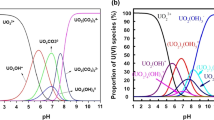Abstract
Poisoning of ion exchange resin often occurs in uranium hydrometallurgy processes, which reduces or even depletes the adsorption capacity of uranium adsorption. Many regeneration methods have been investigated but their static desorption efficiency is undesirable and only the recovery rate is considered in the selection of regenerant. In this paper, NaClO was selected as an antidote based on a series of investigation indexes. After detoxification by dynamic elution, all performance indexes of the regenerated resin are close to those of the new resin. Compared with static method, reagent consumption and detoxification time can be saved. At the same time of reducing the cost and waste liquid discharge, it also improves the work efficiency.











Similar content being viewed by others
References
Zhang Y, Xu GF (1991) Ion exchange and uranium extraction. Atomic Energy Press, Beijing
Dixit F, Barbeau B, Mohseni M (2018) Simultaneous uptake of NOM and microcystin-LR by anion exchange resins: effect of inorganic ions and resin regeneration. Chemosphere 192:113–121
Xu JH, Su ZJ, Cui YX, Han JT, Chen LP (2019) Study on additives in cationic resin regenerant. China Well Rock Salt 50(03):38–42
Gao ZP, Zhao WL, Jiang D, Ding D, Yan AJ (2010) Reason analysis of strongly alkaline anion exchange resin & its recovery technology. Smart Power 38(7):59–61
Zaganiaris EJ, Xu GF (1983) Influence of physical and chemical structure of ion exchange resin on resin silicon poisoning in uranium hydrometallurgy acid leaching solution. Hydrometall China 01:23–30
Wang QL (2009) Uranium extraction technology. Engineering University Press, Harbin
Zhang GW, Xu GF, Zhang Y, Zhao GR, Liu XZ, Guo SH (1983) Studies on mechanism of silica fouling of anion exchange resin (I)-relationship between extents of silica adsorbed and organic structures of resins. Uranium Min Metall 03:28–34
Zhang GW, Zhao GR, Xu GF, Zhang Y, Liu XZ, Guo SH (1984) Studies on mechanism of silica fouling of anion exchange resins (II)-relationship between polymerization of silicic acid and silica fouling of anion exchange resin. Uranium Min Metall 02:11–18
White DA, Zhang GW (1983) Silicon poisoning and its effect on ion exchange in fixed bed. Hydrometall China 01:31–34
Wen ZG, Yao YX, Xu GL, He K, Zheng JP, Zhang Z (2017) Treatment of resin poisoned by molybdenum in acidic in-situ leaching solution containing uranium. Hydrometall China 36(05):397–400
Wang CS, Pi WC, Dong SQ (1990) Behavior of Mo, Si and other impurities in synergistic elution of uranium with (NH4)2SO4–(NH4)2CO3. Uranium Min Metal. 9(1):31–36+8
Yang RM, He QZ, Yu XR, Shen DH, Xie LY (1990) Dissolution of hydrolyzed titanium precipitate and regeneration of resin poisoned by titanium. At Energy Sci Technol 24(05):82–85
Yang BH (2002) Uranium processing technology. Beijing Institute of Chemical Metallurgy Nuclear Industry, Beijing
Wan T, Cai ZS, Zhang TT, He JL, Zheng Q (2018) Synthesis of water-soluble N, O-hydroxyethyl chitosan. Chem Res Appl 30(03):395–399
Sun K, Zhao ZH, Tang Y, Huang W (2015) Effect of different type silica sol on the performance of Si–Al based catalysts for dimethyl ether synthesis in a slurry reactor. J Taiyuan Univ Technol 46(05):508–513
Ye T, Qiao HX, Huang Y, Guo JC, Ma CM, Ru P, Chen FF, Yuan CP, Liu H, Su ZB, Zhang XJ, Gao Y (2018) Preparation and characterization of silicon, silver, fluorine co-modified hydroxyapatite nano-biofilms. Spectrosc Spectr Anal 38(4):1198–1202
Dong HP, Chen KJ, Zong B, Jing EL, Wang H, Dou RF, Guo Y, Xu J (2017) Investigation on luminescent defect state related to N–Si–O bonding in amorphous oxygenated silicon nitride film. J Nanjing Univ (Nat Sci) 53(03):392–398
Zhang LL, Mu HR, Ji ZX, Xuan Y, Bai SQ (2016) Effect of EDTA on the silica scale formation and its mechanisms. Bull Chin Ceram Soc 35(01):237–243
Triki M, Tanazefti H, Kochkar H (2017) Design of β-cyclodextrin modified TiO2 nanotubes for the adsorption of Cu(II): isotherms and kinetics study. J Colloid Interface Sci 493:77–84
Han RP, Zou WH, Wang Y, Zhu L (2007) Removal of uranium (VI) from aqueous solutions by manganese oxide coated zeolite: discussion of adsorption isotherms and pH effect. J Environ Radioact 93(3):127–143
Hua R (2017) Study on recovery technology and economy of associated rhenium resources in in-situ leaching mining of sandstone-type uranium deposits. Atomic Energy Press, Beijing
Acknowledgements
This work was financially supported by the National Natural Science Foundation of China (21761002), the Nuclear energy development project (technology for the mining and metallurgy of associated uranium resources-on the demonstration of uranium co-mining in Bayan Ura, Inner Mongolia) and the Jiangxi Provincal Key Laboratory of Mass Spectrometry Science and Instrument Development Fund (JSMS201607).
Author information
Authors and Affiliations
Corresponding author
Additional information
Publisher's Note
Springer Nature remains neutral with regard to jurisdictional claims in published maps and institutional affiliations.
Rights and permissions
About this article
Cite this article
Cai, J., Li, J., He, F. et al. Study on detoxification behavior of poisoned resin in neutral uranium hydrometallurgy process. J Radioanal Nucl Chem 328, 1115–1126 (2021). https://doi.org/10.1007/s10967-021-07696-x
Received:
Accepted:
Published:
Issue Date:
DOI: https://doi.org/10.1007/s10967-021-07696-x




